This was the week I should not be publishing a newsletter. We were supposed to be on a small schooner for a couple of weeks, sailing around the Gulf of St-Lawrence, dropping in on Newfoundland and the French outpost of St-Pierre et Miquelon on the way, watching birds and seals and usually inaccessible wildlife on isolated islands. Today we should have been with the wild horses and seals on Seal Island far off the Nova Scotia shore (https://nsnt.ca/seal-island/). But, best laid plans of mice and men and all that laid waste to our plans. So you get the 1001 Species newsletter instead, a little shorter than usual … luck comes your way.
Wildlife Gardening Extra
The right way to leave stems for native bees
You will have read a good number of articles recently, not least here, about the desirability of leaving plant stems standing through the winter so that resident birds can have access to seed heads and because native bees and others will lay eggs in hollow stems, the young emerging in the spring or summer following. That’s the simple overview that does good things for the bees.
But what is really going on with the bees? Let’s look at their biology. Tufts University in Massachusetts a couple of years ago outlined the three-year cyclical process in a web article from which I have abstracted these key points.
We are speaking about tall native plants with hollow or pithy stems such as joe-pye weed, wild bergamot, mountain mint, coneflowers Rudbeckias, and swamp milkweed amongst several others.
First Year, new plants
Bees don’t nest in actively growing stems, they want old and dry ones from the year before. Let this year’s stems stand in the fall to allow any seeds to be eaten by overwintering birds, and to create homes for next year’s bees.
Second Year
Cut the dried overwintered stems back to between 6-18” tall in spring, new growth will soon hide them and bees will lay eggs in these stubs you left standing from year one. This now where it starts as a new generation of bees find the stubble and lay eggs which will develop inside the cavities into larvae and finally adults that stay in the stems and hibernate through the second winter. Bees won’t emerge from these old stems until next growing season (year three).
Third Year
In spring of year three, those stems you left in year one contain bees that emerge and start the cycle again; stems produced in year two do not yet contain bees. Leave both generations of stems standing throughout the year. Spring-active bees will emerge from year 1 stems by June, and fall-active species might not emerge from year 1 stems until August or early September. These new bees will nest in year 2 stems, so leave them standing!
Remember, year one you produce stems, in year two bees lay eggs in the stubs of those stems, in year three new bees emerge and the cycle repeats.
So Basically, Just Do this.
Each fall, leave stems standing through the winter so that there are seeds for birds
In spring cut back to 6”-18”, and NO SHORTER. These dry stems will soon be hidden by new growth and will be ready for new eggs to be laid inside them.
You will be producing new bees by the third year and in every year thereafter.
Temperatures are moderating but we have had a run of excessive heat for the time of year. Across the garden from where I am writing this is a tall, beautiful, absolutely non-native Katsura tree. Just a few years ago on this date it was a shining golden-yellow colour from top to bottom (that’s why you grow Katsuras) that almost glowed at dusk. It’s a gorgeous tree and it is “supposed” to be colouring up this week - instead it is still green. Something is wrong with our climate and out world when such striking changes become obvious. (see the footnote to this post).
What else is happening when I go out for a walk, or potter in the garden? Something cheerful and interesting? One way to follow the serendipitous observations that come to our attention whilst we are out walking is to subscribe to my very much shorter Substack that appears daily under the title of “Whilst out Walking,” where you will find simply a daily photograph, occasionally two, and not many words. Some followers have told me it goes well with a mid-morning cup of tea or coffee to get them started on the day - it appears at 10am ET. Meanwhile … here are this week’s round-up highlights with rather more words … thanks for being here.
Bald-headed Birds
Have you noticed bald birds at your feeders in recent weeks? In the fall, Mourning Doves and some other species go through a seasonal moult which makes them look worryingly sick when it is the head that is denuded of feathers as in this specimen. Wear and tear of feathers is an issue that affects all birds, and worn out feathers do need to be replaced periodically. During moulting, Mourning Doves (snd Cardinals and Blue Jays and others) gradually drop their old feathers, starting from the head and moving towards the tail. The process is gradual so that birds don’t lose all their feathers at once, which would render them unable to fly and vulnerable to predators. Once the old feathers are shed, new feathers begin to grow in their place, these are initially covered in a protective sheath that later falls off to reveal the fully formed, new feather. The process of growing new feathers takes time and energy, and so the birds may appear subdued and less active during moulting … this fellow was certainly subdued - he just sat there slowly blinking for about a quarter of an hour. Undergoing moult at this time of the year ensures that the bird has a warm set of feathers in prime conditions for the coldest months.
Did you know? … Mammals undergo something comparable with what is known as a “fur cycle” during which over a period of time fur is shed and replaced. This starts at the nose and moves as a wave towards the tail so usually is not visible.
The Juncos are here … already
Dark-eyed Juncos are the “winter sparrows” that come south to Montreal when things get tough in their northern territories. Small, grey and white birds and tough as nails … but winter birds in the minds of most people. On Monday a small flock came through the garden on a day of unseasonably warm sunshine that felt more like summer thane early fall. Looking at the records, a late September arrival is not unusual and a friend in Ottawa wrote that Juncos were already seeming to outnumber other sparrows. For all that though, their presence without at least a bit of seasonal chill just seems wrong. I look forward to them hopping around the deck eating seeds falling on the snow from the feeders we will have filled. Cheery birds and great favourites, but it just didn’t feel right … or maybe they know something about the winter weather ahead that we don’t.
A return of the flock a couple of days later had the addition of a considerable number of Chipping Sparrows … and a Yellow-rumped (Myrtle) Warbler


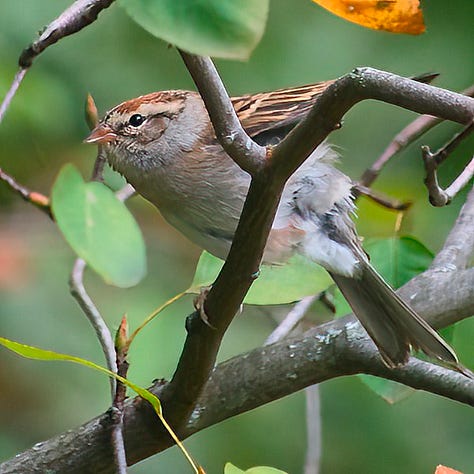
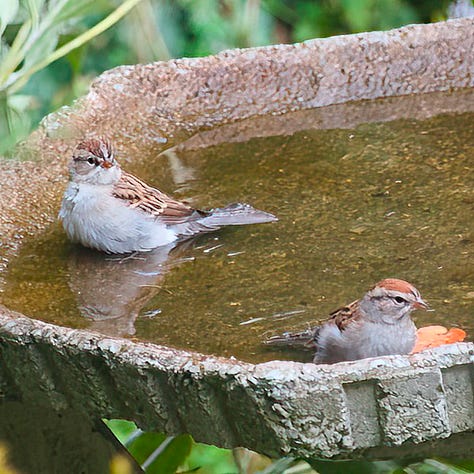
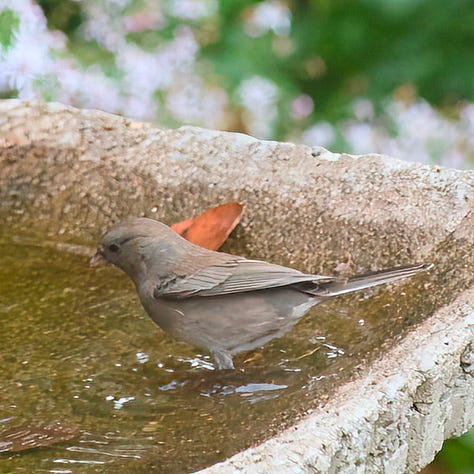

Slowing Down, Getting Prepared
We make a couple of bird feeders available during the summer months but most birds find their presence more of a convenience rather than a necessity, there being plenty of wild food they can choose from. Once the migratory birds have left to go south, the local resident birds start looking around in autumn for consistent food options and so there is benefit to our making provision for the cold weather. Of course, being good and obedient wildlife gardeners our native plant “mead” is not cleared at the end of summer but will be left standing with seed heads above the snow. Even that bounty will be gone, for the most part, by the winter solstice and so we add even more seed feeders to our armoury. This week we started to get things ready and within a very short time lots of birds were checking out what was available. They are very good at spotting a feeder full of seeds from the other end of the road.
We try to provide something for everyone, knowing that not all birds like the same food - or can even handle it, their beaks having evolved to deal with this seed and not that seed. Some prefer to perch to eat while others like to think they are feeding on the ground and so opt for a platform feeder on which they can stand on to select each seed. Most like at least some suet, others go for peanuts while a majority can manage black sunflower seeds and other small seeds or even tiny nyjer for the finches. The birds enjoy the winter food, we enjoy their presence and generally speaking, all’s right with the world. By the time that the snow arrives we will have about eight different feeders for them to work on.
This week’s ponderable post:
Autumn Leaves and American Elections
This is really nice. Politics creeps into the last sentence but the rest is just about falling leaves. Much more peaceful than what we read in the regular media …

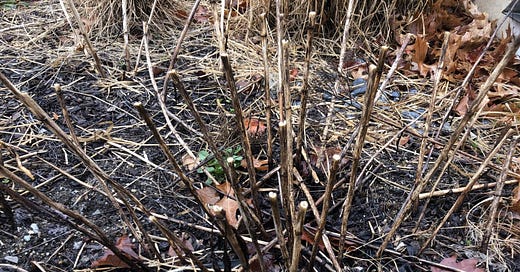





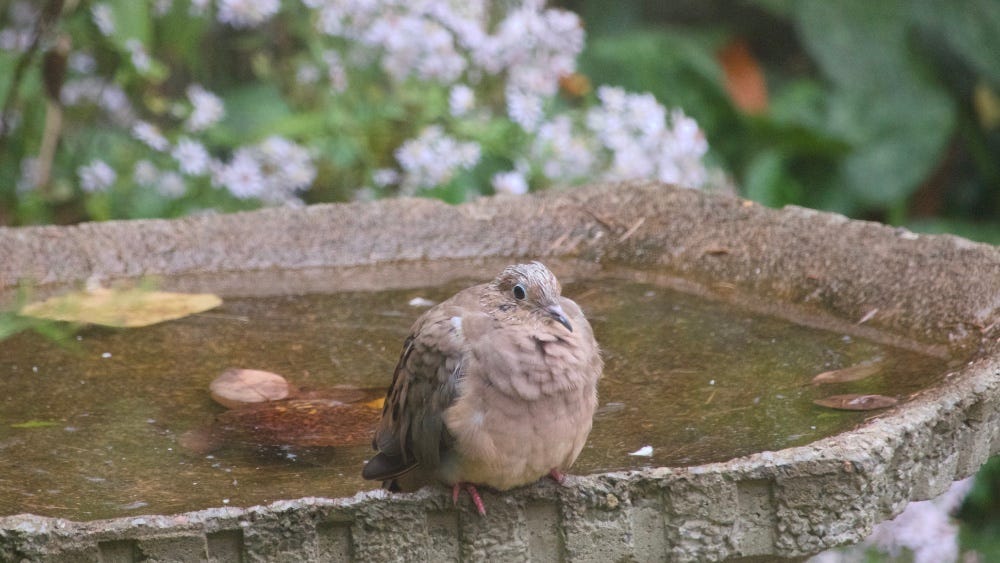
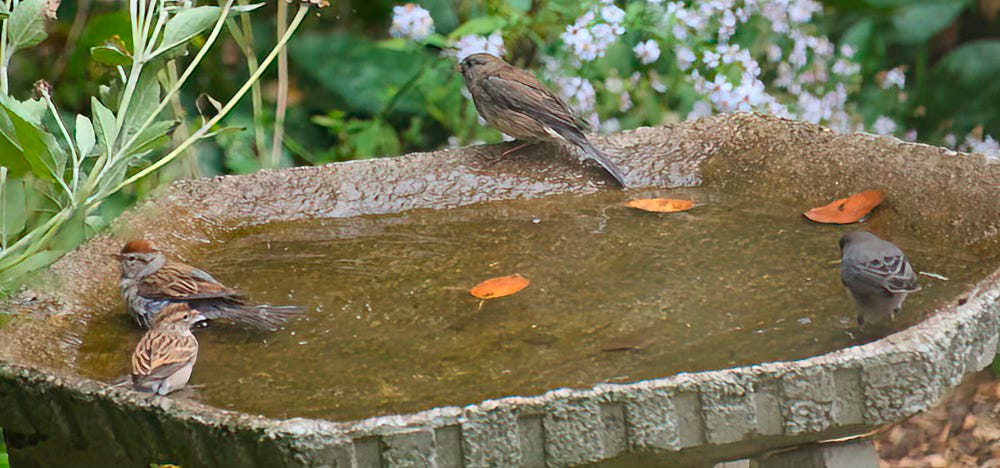



Great post, beautiful birds. I always leave my garden stalks and stubble up in the fall and winter for the birds, insects and wildlife. It's so important.
So interesting to read about the bees, Richard. You have such a beautiful bevy of birds at your bird bath, I don't know how you manage to get anything done!